High art
Phoenix Award recipients rise to top of creative community
Nine years ago, the Lawrence Arts Commission introduced a series of awards to recognize excellence in the arts. It seemed like a noble idea.
They called them the Phoenix Awards and designated seven categories: visual arts, arts volunteer, performing arts, arts education, literary arts, musical arts and exceptional artistic achievement.
But the first-ever Phoenix Awards nearly failed to rise from their ashes. When the deadline rolled around, no nominations had been received. A deadline extension and a series of newspaper ads and articles took care of that, though, and the first crop of winners was recognized in May of 1996.
The Phoenix Awards have since become a mark of great accomplishment for members of the Lawrence creative community.
This year’s winners will be honored during a public ceremony at 2 p.m. today at the Lawrence Arts Center, 940 N.H. Recipients will receive awards created by Lawrence artist Grace Carmody.
Here’s a taste of the winners’ accomplishments:
Stephen Johnson
Exceptional Artistic Achievement
Stephen Johnson is the art world’s version of a jack-of-all-trades.
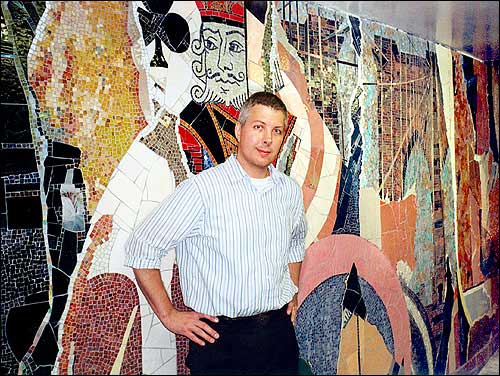
Stephen Johnson has won the Phoenix Award for Exceptional Artistic Achievement. He is pictured in front of the glass mosaic mural he created for a subway station in Brooklyn, N.Y.
Whereas most artists choose one medium, the 1987 Kansas University graduate paints, draws, writes and illustrates children’s books, designs magazine covers and creates large-scale public artworks.
“I look at some colleagues of mine who do nothing but one thing and I’m a little envious because they know when they wake up exactly what they’re doing. And they don’t have to stress out too much about trying to reinvent themselves,” Johnson says. “But then if the market disappears for that work or whatever, it’s a difficult position to be in.”
Judging by his string of recent commissions, Johnson’s hands-in-everything strategy seems to be working.
The Lawrence Arts Commission in October chose Johnson from among a handful of national finalists to create a $50,000 sculpture to occupy a highly visible downtown street corner. The abstract steel sculpture, “Free Form,” which celebrates the city’s free state heritage, should be in place by spring, Johnson says.
Last year, Johnson beat out a slew of regional artists competing to create a Lied Center Lasting Gift in honor of the performing arts venue’s 10th anniversary. His vividly colored, aluminum wall relief, “Arrangement in Red, Blue and Gold,” elicited murmurs of wonder and excitement when it was unveiled in April.
In addition to another recent local commission — a painting to celebrate the 125th anniversary of KU’s law school — Johnson just completed a major Percent for Art project for the DeKalb Avenue Subway Station in Brooklyn, N.Y. The 66-foot-long mural, called “DeKalb Improvisation,” gets its color from thousands of glass mosaic tiles custom made in Germany for the project.
Although keeping up with so many commission often leaves Johnson exhausted, the efforts are worth it, he says, because he’s making a living doing what he loves.
Johnson honed his skills at navigating the business end of the art world while working some 13 years in New York City after graduating from KU. His youthful hustle landed him three TIME magazine covers in one year, for example.
In 1996, one of Johnson’s children’s books, “Alphabet City,” won a Caldecott Honor Award and was named one of The New York Times’ best illustrated books of the year. His work is in public and private collections throughout the country.
Bill Carswell nominated him for the Phoenix Award.
“His national reputation serves to draw recognition to Lawrence as an arts city,” Carswell says of Johnson, “and his work is ambassadorial for Kansas.”
— Mindie Paget
Caryn Mirriam-Goldberg
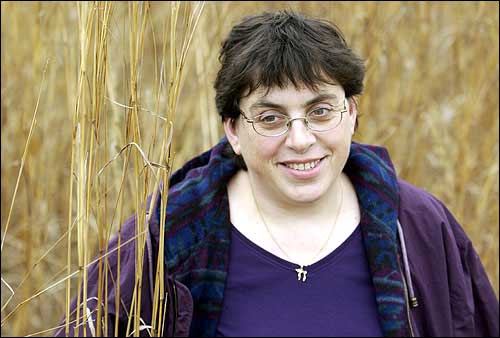
Lawrence poet Caryn Mirriam-Goldberg has won a Phoenix Award for Literary Arts.
Literary Arts
Lawrence poet Caryn Mirriam-Goldberg discovered long ago that she was hardwired to write.
It helps her live in the moment, hear her inner voice, navigate her way through life and be at ease with its mysteries.
“And along the way I’ve discovered that when other people have the space to write what they have to say — in their own words, knowing that they will be listened to — what they write is very powerful,” Mirriam-Goldberg says. “Whether somebody is a professional writer or not has little to do with the potency of what they write in many cases.”
Which gets at the heart of Mirriam-Goldberg’s career. Outside of her own poetry and nonfiction, the 21-year Lawrence resident has long conducted writing workshops with diverse populations — mothers who live in low-income housing, people struggling with cancer or other illnesses, anyone looking to grow or heal through writing.
The mother of three also coordinates the transformative language arts program at Goddard College in Vermont, where she travels twice a year but otherwise communicates via e-mail with her students, who are scattered across the country.
To stay connected with her own work in the midst of her hectic schedule, Goldberg tries to honor a convention she created to maintain her sanity: Write and Wander Wednesdays. So midweek she often can be found walking the streets of downtown Lawrence or burrowed into a coffeeshop corner, pecking away at her laptop computer.
Mirriam-Goldberg’s poetry and prose have been published in more than 60 literary journals. The Kansas University graduate and certified poetry therapist is author of “Write Where You Are: How to Use Writing to Make Sense of Your Life” and two poetry collections, “Lot’s Wife” and “Animals in the House.”
Denise Low, a poet and instructor at Haskell Indian Nations University, was one of three people who jointly nominated Mirriam-Goldberg for a Phoenix Award.
“Caryn Mirriam-Goldberg adds magic to the world,” Low says. “Her poems cast spells on readers, leading them into inner realms as she transforms the physical dimension.”
— Mindie Paget
Henry Fortunato
Visual Arts
Never before has the Lawrence Arts Commission presented a Phoenix Award to someone whose primary medium is a Web site.
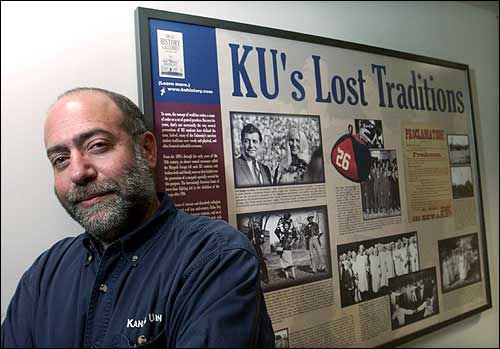
Henry Fortunato, who won a Phoenix Award for Visual Arts, works with the Kansas University History Project. Fortunato is pictured next to one of the many KU history boards he helped bring to fruition inside the Kansas Union.
Maybe it takes someone who loves history to make history.
Henry Fortunato, who earned his master’s degree in American history from Kansas University, helped create www.kuhistory.com. He spent two tireless years getting the site ready for its launch.
“My wife calls it my fourth child,” he says.
The interactive site features an unusual or important anecdote from KU history for nearly every day of the year. Each piece uses writing, photos, images of original documents or other media to tell the story. Fortunato stresses that the site is not a love letter to the university. Nothing has been swept under the rug.
“What makes it work is that it’s not a sanitized version,” Fortunato says. “None of the stories have been whitewashed.”
Fortunato says the response has been extremely positive. He’s now working on a pilot Web site that details the history of the entire state, www.kansashistoryonline.org.
In addition to his work on the Web, Fortunato also took part in the installation of 10 panels on the third floor of the Kansas Union about the history of KU. He says the visual component of the panels, together with the Web site, made him a fit for the Phoenix Award for Visual Arts. Though he does consider himself part of the art community, the news of his award came to him out of the blue, he says.
“I think it demonstrates that Lawrence is forward-thinking,” Fortunato says. “The Web is a new kind of canvas for art to be created on.”
David Mucci, director of KU Memorial Unions, says he nominated Fortunato because he has found a new way to tell history.
“History can tend to have a real dusty look and feel to it,” Mucci says. “What Henry has been able to do is bring it alive vibrantly.”
Despite devoting his recent life to Kansas history, Fortunato didn’t live in the state until 1997. He was born in New York and spent most of his life in Washington, D.C. Part of the challenge when he came to Kansas was overcoming his East Coast bias. He discovered the richness of Kansas history while doing research for his graduate classes. He wrote two papers on local subjects because he didn’t want to fly back to the East Coast to find primary sources. After two semesters at KU, he ended up liking the work so much that he switched his emphasis to Kansas history.
“There’s an incredible connection that KU people have with the university,” he says. “KU has gone through some tough times and always come through with flying colors.”
— Kendall Dix
Beth Schultz
Literary Arts
Slowly but surely, Beth Schultz has become a lover of prairies.
The native Michigander came to Kansas University in 1967 to teach English and remained on the faculty more than 30 years. But for decades she felt more at home near the Great Lakes of her girlhood and the seas she’s come to love through her scholarly fascination with Herman Melville’s “Moby Dick.”
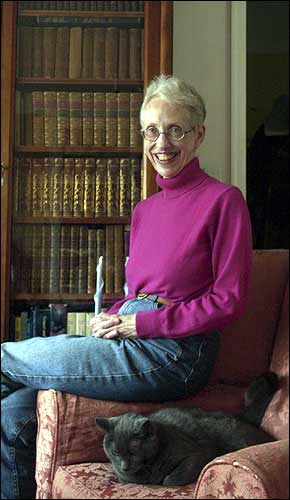
Beth Schultz, a Kansas University professor emerita of English, has won a Phoenix Award for Literary Arts. Schultz is pictured on Monday at her Lawrence home.
And while those geographies remain near and dear to Schultz, she has cultivated an affinity for her adopted home on the range.
“It’s been in the last few years that I myself have become a Kansan,” says Schultz, who retired from KU in 2002. “The prairie is a fabulous ecosystem, and although there are a diversity of ecosystems that are very flashy … the prairies are equally astonishing in their subtlety.”
For the past several years, Schultz has been writing poetry — about her mother, her Michigan summer home and the Kansas environment. Her poem “Evidence,” about the Haskell-Baker Wetlands, is part of the Kansas Conference on Imagination and Place’s recently issued portfolio of writing and images. Schultz also writes a column called “Sense of Place” for the Kansas Land Trust’s newsletter.
But her reach is by no means strictly local. Schultz’s poems have been published in literary journals across the country. She’s an internationally renowned Melville scholar who has published extensively on the 19th-century American writer. And “Shoreline: Seasons at the Lake,” Schultz’s memoir of the Michigan lake community where she has spent summers with her family since she was a child, was published by Michigan State University Press in 2001.
In addition to her academic work, Schultz has long been an advocate for literacy and how it can promote equal opportunities for women, minorities and economically disadvantaged people. She also has been an advocate and mentor for countless area writers and artists.
“Beth deserves the Phoenix Award not only because of her impressive creative achievements, arts involvement, and leadership in making the arts accessible to all Lawrence citizens, but also because she embodies the creative spirit of a true artist,” says Lawrence Arts Center gallery director Rick Mitchell, who, along with Maril Hazlett, nominated Schultz for the Phoenix Award.
“For Beth, expressing that creative spirit is inseparable from community service and arts outreach.”
— Mindie Paget
Steve Mason
Musical Arts
Steve Mason picked up the ukulele back in the fourth grade and never turned back. These days, he doesn’t just play music — he lives it.
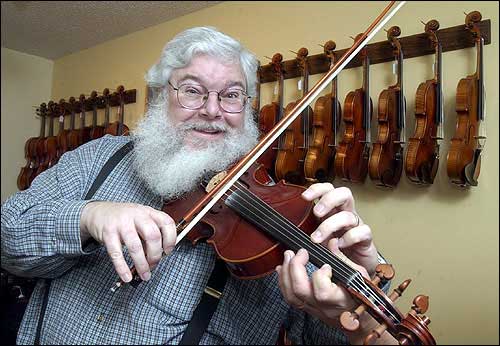
Steve Mason, a multi-instrumentalist, member of the Alferd Packer Memorial String Band and long-time supporter of musical arts in Lawrence, is the recipient of this year's Phoenix Award for Music Arts. In keeping with his zany sense of humor, Mason has a friend lend him a third hand while fiddling a tune.
After a stint in a rock band as a teen, Mason returned to his more traditional roots when he moved to Kansas from Ann Arbor, Mich., in his early 20s. Working at a Mossman Guitars factory, he picked up fiddling to stand out from the crowd.
“At the Mossman factory, everybody sat around at lunch and flat-picked on the guitars lying around,” Mason says. “I realized I could fit in better by being the only fiddler there. So I learned to fiddle.”
Now Mason works the fiddle both for a living and for fun. As a luthier, someone who repairs and creates stringed instruments, Mason had to master each of the instruments he works with. His repertoire has grown to include the viola, mandolin, banjo, cello, guitar and dulcimer.
“It takes about 10 years to master your first instrument, but after that it’s real easy to pick up the rest,” Mason says. “You only have to learn to read music once. It’s just the dexterities that are different.”
Mason also plays outside his workshop, fiddling in the Alferd Packer Memorial String Band, jamming with a dozen or more of his music buddies on Sunday nights and appearing as Santa Claus in the Saint Nicholas String Band.
He hones his improvisational skills during those weekly jam sessions , where musicians play over and around each other instead of politely waiting their turn for some solo time. Those skills come in handy during his performances with the Alfred Packer band, which is working on a CD for spring.
“Officially, I call it a costumed old-time string band,” Mason says. “My philosophy is that people like the music they know. If you want to give them something they don’t know, you have to give them something else with it. That’s why we use fireguns, costumes and some stage humor.”
“I love to perform. I love to engage an audience and hear their response. It’s just so much fun.”
— Lauren Airey
Linda Reimond
Arts Education
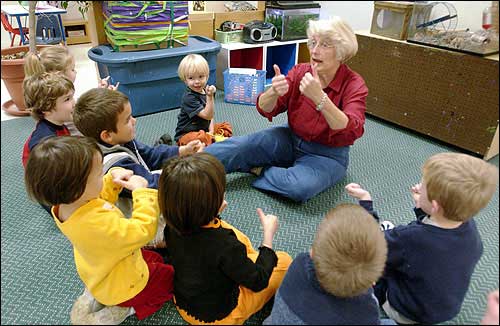
Linda Reimond has won the Phoenix Award for Arts Education. Reimond is pictured teaching an arts-based preschool class at the Lawrence Arts Center.
Linda Reimond switched her major to education when she was a senior in college, and she had already been offered a job by the time she graduated.
“I guess you could say that my career found me,” Reimond says.
Reimond has been teaching young children for 27 years. When the preschool program opened at the Lawrence Arts Center in 1985, she quit teaching kindergarten in public schools and became the first teacher and director of the program.
Reimond says Candi Baker, who was the education director at the time, brought the idea of an arts-based preschool from California. Though the program is somewhat nontraditional, what began as one class with 10 children has grown to seven classes with 137 children.
“I always say you have to be a little bit of a rebel to send your child here,” Reimond says. “Our program is different. We’re painting all over the place.”
Reimond says children in her program still learn the same things they would learn from a traditional education. Reading, math and science all have a correlation with things like music and painting, she says.
“They learn to think creatively when solving problems,” Reimond says. “The arts lets them try thing out. It doesn’t have to look like the teacher’s or anybody else’s.”
Reimond says watching the wonder and enthusiasm as the kids learn is the best part of her job. However, she also says there is more emphasis on test scores today and less on the arts. Still, 16 out-of-town families from as far away as Shawnee feel the arts are important enough to put their kids in preschool at the arts center.
Reimond says her Phoenix Award came as a surprise because there are so many good educators in town. Arts center director Ann Evans nominated Reimond.
“It means a lot to be recognized by someone who’s your boss,” Reimond says. “It’s quite an honor.”
— Kendall Dix
Karl Gridley
Arts Volunteer
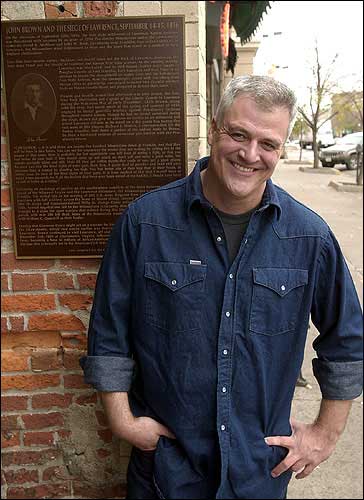
Karl Gridley is the Phoenix Award winner for Arts Volunteer. One of Gridley's efforts resulted in the establishment of a plaque outside the Free State Brewery on abolitionist John Brown and the siege of Lawrence in September of 1856.
Karl Gridley wasn’t expecting an award for his contribution to the arts. After all, he’s a history buff with an affinity for Lawrence history and a knack for saving old buildings.
“I got to read some of the letters from people who nominated me,” Gridley says. “They thought I was providing a base for arts preservation. I was just so surprised. I don’t even like talking about myself too much.”
Gridley’s first major restoration projects began in 1991 when the charter member of the Douglas County Preservation Alliance took interest in repairing a stone schoolhouse built in 1871 in what is now Clinton State Park. The building was named after Thomas Barber, who was murdered by pro-slave activists on Dec. 6, 1855, and became a martyr for the abolitionists of his time. Gridley contacted the Kansas University School of Architecture about localizing a program that sent students to Italy to repair older buildings.
“I convinced them that there were some buildings in Douglas County that could use some tender loving care,” Gridley says. “Thomas Barber was one of the first victims of Bleeding Kansas violence, the first martyr for the cause. John Brown came up to see him laid in state and he wrote a letter about it. It was the first time he wrote about a civil war.”
Brown’s legacy is another of Gridley’s interests and the theme of an ongoing project to tie Brown’s history into a viable tourist attraction. Gridley is trying to bring together all the stories of Brown from all the Kansas towns he touched. He would like to see a state park at the site of the Battle of Black Jack near Baldwin, where Brown fought one of the first battles between free state and pro-slavery forces in Kansas.
“These little towns are all isolated, and they have stories they want to tell,” Gridley says. “A lot of those stories are connected to John Brown and Bleeding Kansas. If we can get a narrative and story line that connects them, we can fill a void in this area. People tend to laugh at the idea of tourism in Kansas, but we’ve got some real history to share.”
— Lauren Airey
| 1996, award created by Ron HintonLiterary Arts: Jim McCraryMusical Arts: Bill CrahanPerforming Arts: Mary DovetonVisual Arts: Wayne WildcatArts Education: Sarah OblingerExceptional Artistic Achievement: Robert SudlowSpecial Commissioner’s Award: Herk Harvey1997, award created by Dick Rector/Free State GlassLiterary Arts: Luci TapahonsoMusical Arts: Stan ShumwayPerforming Arts: Ric AverillVisual Arts: Ardys RambergArts Education: Alan BrummellExceptional Artistic Achievement: Mike OttSpecial Recognition Award: John Clifford1998, award created by Patricia ShebolaLiterary Arts: Brian DoldorphMusical Arts: Cornel PewewardyPerforming Arts: Candi BakerVisual Arts: Judi Geer KellasArts Education: Ann EvansExceptional Artistic Achievement: Matt Kirby1999, award created by Linda Samson-Talleur and Cathy LedekerLiterary Arts: Sandra WiechertMusical Arts: Lewis R. TilfordPerforming Arts: Paul Stephen LimVisual Arts: Jim BrothersArts Education: Lynn GreenArts Volunteer: James SeaverExceptional Artistic Achievement: Peter Thompson2000, award created by Jon BlumbLiterary Arts: Denise LowMusical Arts: Robert ReidPerforming Arts: Joan StoneVisual Arts: Jon HavenerVisual Arts: Louis CoptArts Education: Barbara KellyArts Volunteer: Jack Riegle2001, award created by Chris Wolf EdmondsMusical Arts: Winnefred Gallup/Larry MaxeyPerforming Arts: Deborah BettingerVisual Arts: Jan GaumnitzVisual Arts: Joe SkeebaArts Education: Betsy StarmanExceptional Artistic Achievement: Hobart Jackson2002, award created by Jan GaumnitzLiterary Arts: Priscilla HowePerforming Arts: Muriel Cohan/Patrick SuzeauVisual Arts: Laurie CullingArts Education: Maria MartinArts Volunteer: Gunda and Dave HiebertArts Volunteer: Sidney RoedelSpecial Recognition Award: Jan Biles2003, award created by Lisa GrossmanMusical Arts: James S. RalstonVisual Arts: Diana DunkleyVisual Arts: Rick MitchellPerforming Arts: Jennifer GlennArts Volunteer: Jean LominskaSpecial Recognition Award: Judy BillingsExceptional Artistic Achievement: Chris Wolf Edmonds2004, award created by Grace CarmodyMusical Arts: Steve MasonVisual Arts: Henry FortunatoArts Education: Linda ReimondLiterary Arts: Elizabeth SchultzLiterary Arts: Caryn Mirriam-GoldbergArts Volunteer: Karl GridleyExceptional Artistic Achievement: Stephen Johnson |






